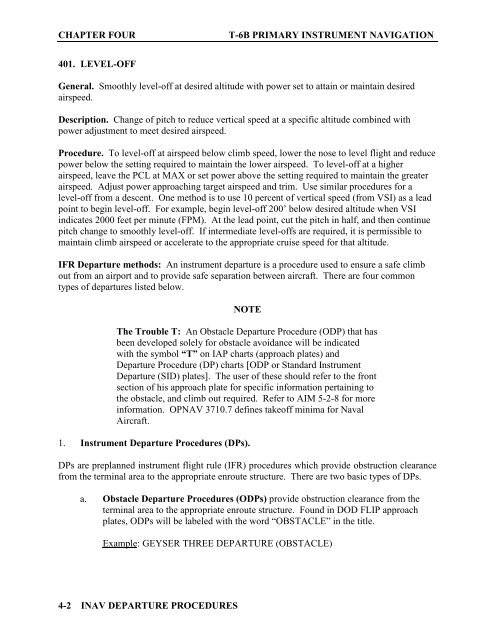Flight Training Instruction - Cnatra - U.S. Navy
Flight Training Instruction - Cnatra - U.S. Navy
Flight Training Instruction - Cnatra - U.S. Navy
You also want an ePaper? Increase the reach of your titles
YUMPU automatically turns print PDFs into web optimized ePapers that Google loves.
CHAPTER FOUR T-6B PRIMARY INSTRUMENT NAVIGATION<br />
401. LEVEL-OFF<br />
General. Smoothly level-off at desired altitude with power set to attain or maintain desired<br />
airspeed.<br />
Description. Change of pitch to reduce vertical speed at a specific altitude combined with<br />
power adjustment to meet desired airspeed.<br />
Procedure. To level-off at airspeed below climb speed, lower the nose to level flight and reduce<br />
power below the setting required to maintain the lower airspeed. To level-off at a higher<br />
airspeed, leave the PCL at MAX or set power above the setting required to maintain the greater<br />
airspeed. Adjust power approaching target airspeed and trim. Use similar procedures for a<br />
level-off from a descent. One method is to use 10 percent of vertical speed (from VSI) as a lead<br />
point to begin level-off. For example, begin level-off 200’ below desired altitude when VSI<br />
indicates 2000 feet per minute (FPM). At the lead point, cut the pitch in half, and then continue<br />
pitch change to smoothly level-off. If intermediate level-offs are required, it is permissible to<br />
maintain climb airspeed or accelerate to the appropriate cruise speed for that altitude.<br />
IFR Departure methods: An instrument departure is a procedure used to ensure a safe climb<br />
out from an airport and to provide safe separation between aircraft. There are four common<br />
types of departures listed below.<br />
4-2 INAV DEPARTURE PROCEDURES<br />
NOTE<br />
The Trouble T: An Obstacle Departure Procedure (ODP) that has<br />
been developed solely for obstacle avoidance will be indicated<br />
with the symbol “T” on IAP charts (approach plates) and<br />
Departure Procedure (DP) charts [ODP or Standard Instrument<br />
Departure (SID) plates]. The user of these should refer to the front<br />
section of his approach plate for specific information pertaining to<br />
the obstacle, and climb out required. Refer to AIM 5-2-8 for more<br />
information. OPNAV 3710.7 defines takeoff minima for Naval<br />
Aircraft.<br />
1. Instrument Departure Procedures (DPs).<br />
DPs are preplanned instrument flight rule (IFR) procedures which provide obstruction clearance<br />
from the terminal area to the appropriate enroute structure. There are two basic types of DPs.<br />
a. Obstacle Departure Procedures (ODPs) provide obstruction clearance from the<br />
terminal area to the appropriate enroute structure. Found in DOD FLIP approach<br />
plates, ODPs will be labeled with the word “OBSTACLE” in the title.<br />
Example: GEYSER THREE DEPARTURE (OBSTACLE)
















